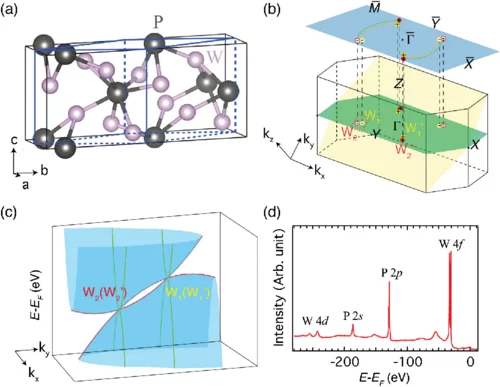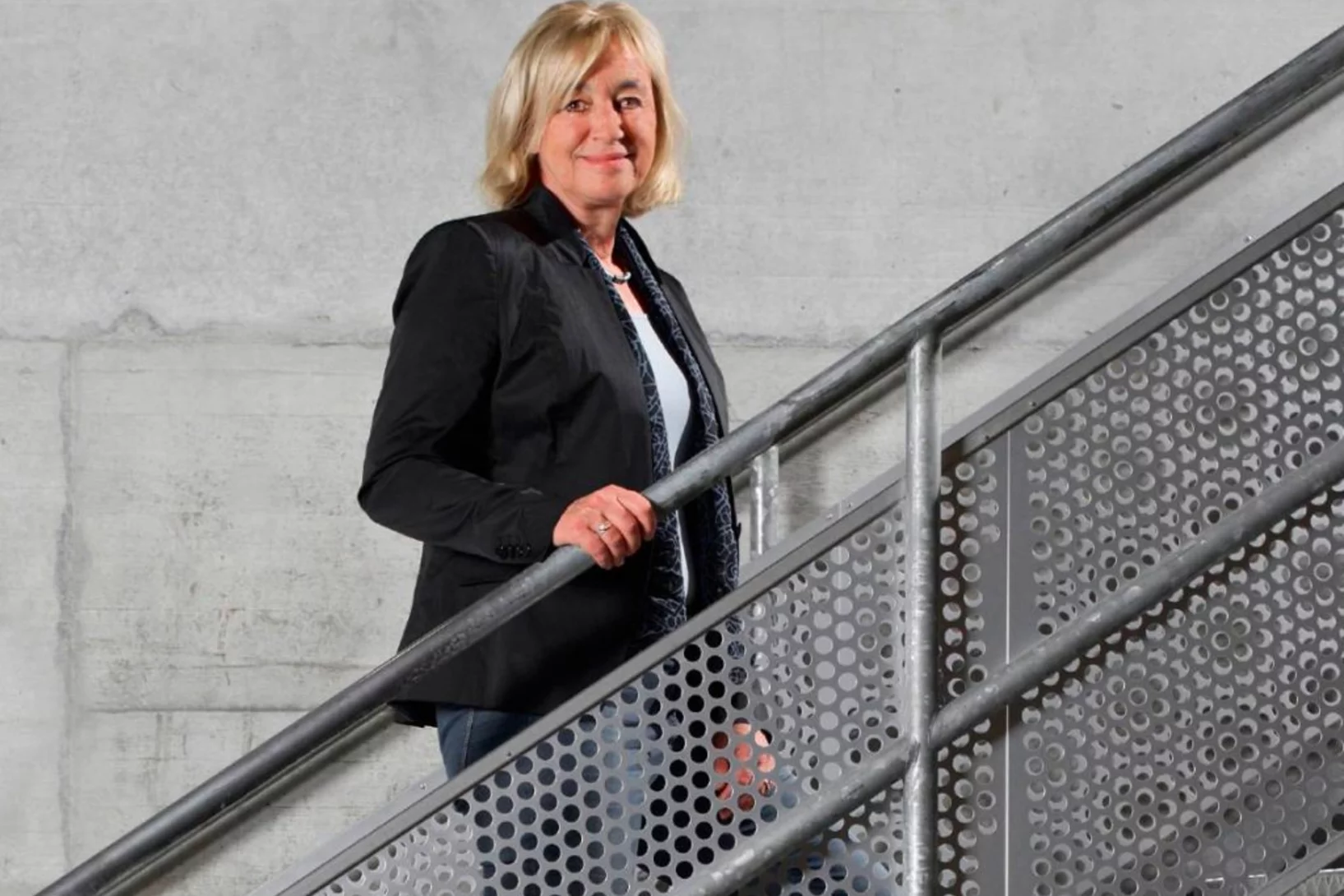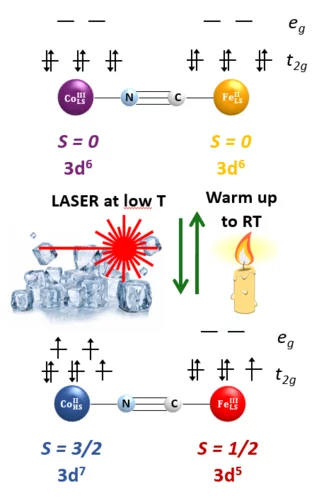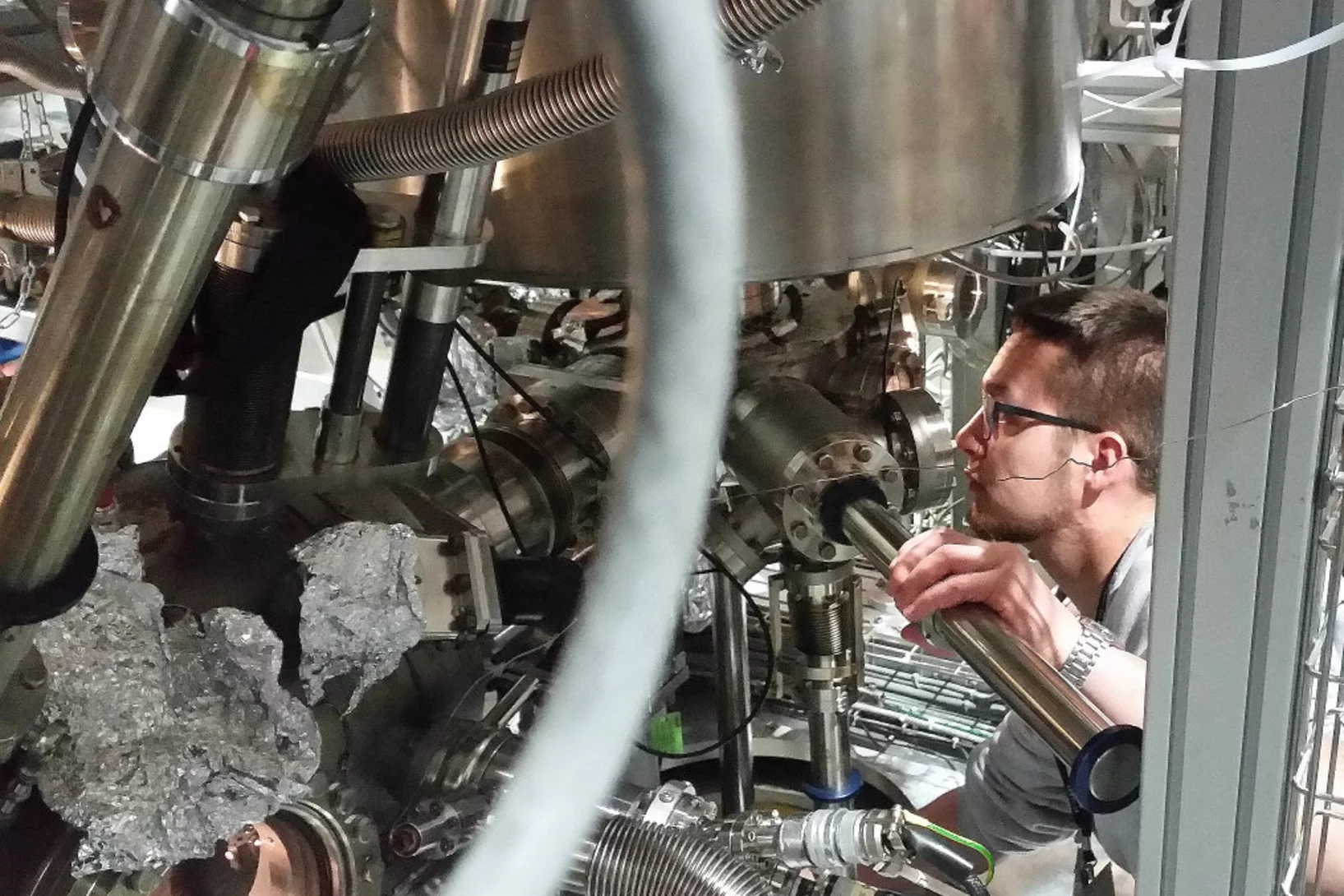An iodine polymeric chain with tunable conductivity
The progressive hydrostatic compression of I2 and I3- units in an organic salt lead to a homoatomic polymeric chain. As the I---I distance collapses the covalent character of the interaction becomes more relevant, leading to a pressure-tunable increased conductivity.
New study gives compelling evidence that tungsten diphosphide is a type-II Weyl semimetal
Researchers at NCCR MARVEL have combined first principles calculations with soft X-ray angle-resolved photoemission spectroscopy to examine tungsten diphosphide’s electronic structure, characterizing its Weyl nodes for the very first time. In agreement with density functional theory calculations, the results revealed two pairs of Weyl nodes lying at different binding energies. The observation of the Weyl nodes, as well as the tilted cone-like dispersions in the vicinity of the nodal points, provides compelling evidence that the material is a robust type-II Weyl semimetal with broken Lorentz invariance. This is as MARVEL researchers predicted two years ago. The research has been published in Physical Review Letters as an Editor's Suggestion.
Prof. Helena Van Swygenhoven presented the plenary Kavli lecture at the MRS spring meeting 2019
Plenary Session Featuring The Fred Kavli Distinguished Lectureship in Materials Science:
Tuesday, April 23
8:15 am – 9:30 am
PCC North, 100 Level, Ballroom 120 D
Carlos Vaz Selected by the Journal of Materials Chemistry C as Outstanding Reviewer in 2018
SIM beamline scientist Carlos Vaz was recognized as outstanding referee for providing high quality peer review for the Journal of Materials Chemistry C (Royal Society of Chemistry).
X‐Ray Writing of Metallic Conductivity and Oxygen Vacancies at Silicon/SrTiO3 Interfaces
Lithography‐like writing of conducting regions at the interface between SrTiO3 and amorphous Si using X‐ray irradiation opens ways for spatially controlled functionalities in oxide heterostructures.
Terahertz-driven phonon upconversion in SrTiO3
Direct manipulation of the atomic lattice using intense long-wavelength laser pulses has become a viable approach to create new states of matter in complex materials. Conventionally, a high-frequency vibrational mode is driven resonantly by a mid-infrared laser pulse and the lattice structure is modified through indirect coupling of this infrared-active phonon to other, lower-frequency lattice modulations.
HERCULES school 2019 at SLS
In the week of April 1-5 PSI welcomes 20 PhD students and postdocs taking part in the European HERCULES 2019 school on Neutron and Synchrotron Radiation. They will attend lectures and perform two days of practical courses at several beam lines of the Swiss Light Source.
A new twist on a mesmerising story
The Einstein–de Haas effect, first demonstrated more than a century ago, provides an intriguing link between magnetism and rotation in ferromagnetic materials. An international team led by ETH physicist Steven Johnson now established that the effect has also a central role in ultrafast processes that happen at the sub-picosecond timescale — and thus deliver fresh insight into materials that might form the basis for novel devices.
Photoswitching in a Molecular Cube
Niéli’s paper is accepted in the Journal of Physical Chemistry Letters! We use X-ray absorption spectroscopy and X-ray magnetic circular dichroism to watch directly how the Co and Fe ions in a molecular cube change their oxidation states and turn from diamagnetic into paramagnetic units upon light irradiation.
A new spin in nano-electronics
In recent years, electronic data processing has been evolving in one direction only: The industry has downsized its components to the nanometer range. But this process is now reaching its physical limits. Researchers at the Helmholtz-Zentrum Dresden-Rossendorf (HZDR) and the Paul Scherrer Institut (PSI) are therefore exploring spin waves or so-called magnons – a promising alternative for transporting information in more compact microchips. Cooperating with international partners, they have successfully generated and controlled extremely short-wavelength spin waves. The physicists achieved this feat by harnessing a natural magnetic phenomenon, as they explain in the journal Nature Nanotechnology.
Additive Manufacturing of High Entropy Alloys
Additive manufacturing of high-entropy alloys combines the mechanical properties of this novel family of alloys with the geometrical freedom and complexity required by modern designs. An approach to additive manufacturing of high-entropy alloys has been developed based on 3D extrusion of inks containing a blend of oxide nanopowders (Co3O4 + Cr2O3 + Fe2O3 + NiO), followed by co-reduction to metals, inter-diffusion and sintering to near-full density CoCrFeNi in H2. A complex phase evolution path is observed by in-situ X-ray diffraction in extruded filaments: the oxide phases undergo reduction and the resulting metals inter-diffuse, ultimately forming the desired fcc-CoCrFeNi alloy (see figure). Linked to this phase evolution is a complex micro-structural one, from loosely packed oxide particles to fully-annealed, metallic CoCrFeNi with 99.6 ± 0.1% relative density. CoCrFeNi micro-lattices are created with strut diameters as low as 100 μm and excellent mechanical properties at ambient and cryogenic temperatures.
New Method for Calculating Soft X-ray Magnetic Circular Dichroism Spectra
Scientists have demonstrated in a combined theoretical and experimental effort that the new ligand-field density functional theory method (LF-DFT) can be used to calculate the X-ray absorption spectra (XAS) and X-ray magnetic circular dichroism (XMCD) of lanthanide compounds from purely structural input.
Watching electrons and switching bits on
Electronics should get smaller, faster, and above all more energy-efficient. These themes are also present in several research groups at PSI. From incremental improvements to complete rethinking – who is currently working on what?
Revealing the role of microstructure architecture on strength and ductility of Ni microwires by in-situ synchrotron X-ray diffraction
The effect of diameter reduction on the mechanical properties of cold-drawn nickel microwires has been analyzed by a combination of in situ X-ray diffraction and electron backscatter diffraction observations.
Sub-ns magnetic domain wall motion dynamics
Magnetic domain walls can be reliably displaced by electrical currents, allowing for the fabrication of retentive magnetic memory elements without mechanically moving parts, such as e.g. the magnetic racetrack memory. Researchers in a joint collaboration between the PolLux endstation of the Swiss Light Source and the University of Leeds were able to investigate the dynamics of magnetic domain wall motion with a sub-ns time step, providing a substantial step forward towards the unraveling of the physical processes behind the current- and magnetic field-induced motion of magnetic domains.
A High Resolution Digital Image Correlation Study under Multiaxial Loading
We have developed a new cruciform geometry with reduced thickness at the center, which allows reaching high plastic strain under equibiaxial loading. The novel thinning method results in excellent surface quality, suitable for electron backscatter diffraction (EBSD) and high-resolution digital image correlation (HRDIC) investigations. We performed an in-situ HRDIC study on a 304 austenitic stainless steel using the new cruciform geometry to follow the slip activity under uniaxial and equibiaxial loadings.
In situ tension-tension strain path changes of cold-rolled Mg AZ31B
The mechanical behavior of cold-rolled Mg AZ31B is studied during in-plane multiaxial loading and tension-tension strain path changes using in situ neutron diffraction and electron backscatter diffracion.
Lorem ipsum dolor sit amet, consetetur sadipscing elitr
Lorem ipsum dolor sit amet, consetetur sadipscing elitr, sed diam nonumy eirmod tempor invidunt ut labore et dolore magna aliquyam erat, sed diam voluptua.
Discrete Hall contribution of magnetic skyrmions
The reliable electrical detection of magnetic skyrmions is of fundamental importance for the application of such topological magnetic quasi-particles for data storage devices. Researchers in a joint collaboration between the University of Leeds and the PolLux endstation have investigated the electrical detection of isolated magnetic skyrmions in applications-relevant nanostructured devices, observing the presence of a strong skyrmion-dependent contribution to the Hall resistivity.
Bernina status first summer shutdown
The summer shutdown was used to install more missing hardware. With the new components the Bernina instrument will be already very close to the full design capabilities when the exciting time of user experiments will begin in 2019.
Moving Atoms by Photodoping
Understanding how and how fast we can drive atoms to create a structural phase transition is of fundamental interest as it directly relates to many processes in nature. Here we show that a photoexcitation can drive a purely structural phase transition before the energy is relaxed in the material that corresponds to a “warmer” equilibrated state.
On the path to new high-performance transistors
The electronics industry expects a novel high-performance transistor made of gallium nitride to offer considerable advantages over present-day high-frequency transistors. Yet many fundamental properties of the material remain unknown. Now, for the first time, researchers at the Paul Scherrer Institute PSI have observed electrons while they were flowing in this promising transistor. For that they used one of the world's best sources of soft X-rays at PSI's Swiss Light Source SLS.
MOOCs – a paradigm shift in education
In March 2018, the nine-week MOOC “Introduction to synchrotrons and x-ray free-electron lasers” (abbreviated to “SYNCHROTRONx”) came online via the edX provider of the École Polytechnique Fédérale de Lausanne (EPFL), created by Phil Willmott of the Swiss Light Source, Paul Scherrer Institute. “MOOC” is an acronym for “massive open online course”, a teaching platform started in the first decade of this century, which has become increasingly popular in the last five to six years. MOOCs have no limits to participation and are free. Some of the most popular MOOCs can attract many tens of thousands of participants. Even the most specialized subjects may have an initial enrollment of over a thousand, more than an order of magnitude larger than that typically found in traditional higher education. There were over 70 million MOOC enrollments covering nearly 10’000 subjects offered by the top five providers in 2017 alone!
Movie directors with extra roles
Data storage devices based on novel materials are expected to make it possible to record information in a smaller space, at higher speed, and with greater energy efficiency than ever before. Movies shot with the X-ray laser show what happens inside potential new storage media, as well as how the processes by which the material switches between two states can be optimised.
Revealing a Living-Dead Magnetic Layer
A peculiar magnetic “dead layer” is detected at the surface of thin films of DyTiO3, a ferrimagnetic Mott insulator. Depth dependent X-ray absorption measurements performed at the X-Treme beamline in the Swiss Light Source indicate that this layer is associated with a deviation of the Ti valence from 3+ toward 4+ at the film surface, suppressing the magnetic coupling between Ti ions and unleashing a strong paramagnetic response from uncoupled Dy ions.
Mechanical response of stainless steel subjected to biaxial load path changes: cruciform experiments and multi-scale modeling
In this work, we have enhanced our originally proposed experiment-modeling synergy in Upadhyay et al. Acta Mat. 2016, to capture the stress evolution in the complex cruciform geometry during arbitrary multi-axial load path changes. We perform cruciform simulations using the implementation of the visco-plastic self-consistent (VPSC) model as a user material (UMAT) into the ABAQUS finite element (FE) solver. We also use the Elasto-viscoplastic fast Fourier transform (EVP-FFT) approach to compute yield surfaces. This experiment-modeling synergy is exploited to understand the mechanical response (including the elastic response, Bauschinger effect and hardening) of 316L stainless steel following biaxial load path changes.
Creation and deletion of isolated magnetic skyrmions via electrical currents
The writing and deletion of magnetic Skyrmions is a fundamental step towards the fabrication of memory devices based on this promising spin configuration. Researchers at the Korea Institute of Technology have demonstrated the writing and deleting of isolated magnetic Skyrmions at room temperature in ferrimagnetic multilayer superlattice stacks using electrical currents.
A first glance at the SwissFEL x-rays wave-front
X-ray Free Electron Lasers (XFELs) combine the properties of synchrotron radiation (short wavelengths) and laser radiation (high lateral coherence, ultrashort pulse durations). These outstanding machines allow to study ultra-fast phenomena at an atomic level with unprecedented temporal resolution for answering the most intriguing open questions in biology, chemistry and physics.
HERCULES at the Swiss Light Source
In the week of March 18-23 PSI welcomes 20 PhD students and postdocs taking part in the HERCULES 2018 school on Neutron and Synchrotron Radiation. They will attend lectures and perform two days of practical courses at several beam lines of the Swiss Light Source.
Photoinduced transitions in magnetoresistive manganites: A comprehensive view
Using the FEMTO slicing source at SLS, we have studied the structural response during the photoinduced transition in a charge-ordered Pr1-xCaxMnO3 thin films. By investigating the dynamics of both superlattice reflections and regular Bragg peaks, we disentangle the different structural contributions and analyze their relevant time-scales. Comparing these results with studies of the charge order and magnetic dynamics, a comprehensive picture of the phase transition linked to a single critical fluence fc is proposed.































